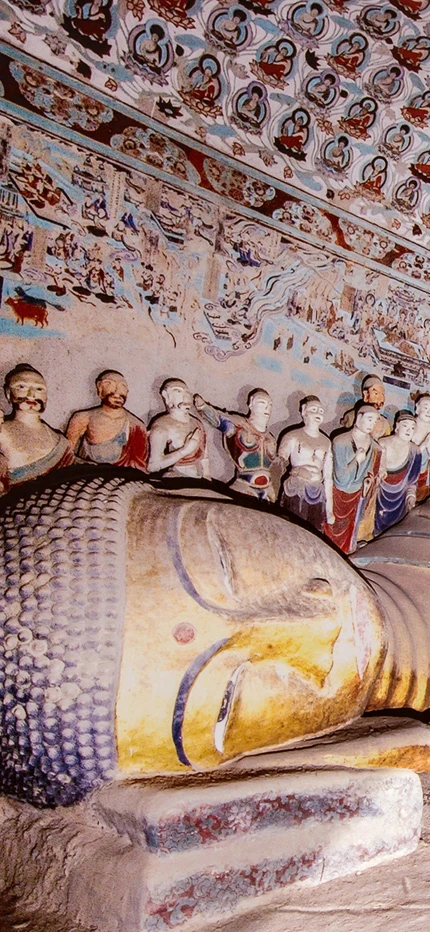Retracing the steps of travellers who have traversed the Silk Road route for millennia is an awe-inspiring experience. Located on the edge of the stark Taklamakan Desert in northwest China is the ancient city of Dunhuang, a green oasis famous for containing one of the most significant collections of Buddhist art in the world. The Mogao Grottoes are a vast complex of 492 caves that were built over 1,000 years beginning in the 4th century. Set against mystical desert-scapes, it is here that you can learn stories about the site’s significance from a renowned expert on Buddhism during this absorbing journey through time.
The Chinese desert outpost was historically a strategically important location where the northern and southern Silk trade routes intersected. The medieval archaeological site flourished during the Tang dynasty (618–907) with over 1,400 monks, calligraphers, nuns and artists living in 18 monasteries. Wealthy traders passing by gave thanks by donating to the construction of new caves after traversing the inhospitable wastelands en route. After the collapse of the Yuan dynasty, the cave network was mainly forgotten until the early 20th century when they were rediscovered by explorers. The grottoes’ main purpose was for worship and meditation whilst also used to store frescoes, paintings and manuscripts. Most notable within the extensive collection is the earliest printed book in human history – the Diamond Sutra – which was produced in 868.
Highlights of an exclusive tour of the Mogao Grottoes, China
"Gain fascinating insights into the region’s history and explore some exclusively reserved caves accompanied by a world authority on Buddhism in China."
Gain fascinating insights into the region’s history and explore some exclusively reserved caves accompanied by a world authority on Buddhism in China. Neil Schmid is an internationally recognised expert in Buddhism’s visual culture. His research centres around the medieval archaeological site in Dunhuang so he is well-placed to provide in-depth insights and enrich your experience here. His next project will be compiling Dunhuang’s findings into “The Comprehensive Guide to Scholarly Resources for Dunhuang Studies”.
After this enriching cultural experience, spend the evening discussing the day’s discoveries with a private alfresco dinner in the serene desert surroundings. Try a range of local specialities and indulge in the spread of Gansu favourites whilst appreciating the sunset views over the dunes. Over the next few days, there are opportunities to visit the striking natural wonders of the region. Witness sunrise from the 300-meter high Mingsha Sand Dunes dubbed by Marco Polo the “rumbling sands” for the sounds they make when the wind blows, and take a camel ride to nearby Crescent Moon Lake, a glistening pool set amidst the vast Gobi Desert and one of the country’s most unusual geographical features.

Visit the Great Wall of Han Dynasty
You’ll also have time to explore the other-worldly Yadan National Geological Park, an ancient eroded lakebed made famous by film director Zhang Yimou in his film ‘Hero’ capturing the stark wilderness of this remote desert region. Yumen Pass provides another point of interest that has witnessed many key historical events in Dunhuang. Yumen means “Jade Gate,” given the volume of jade that once passed through this important trade post along with travelling merchants and military generals over the centuries. Today you can visit several sites including the Small and Big Fangpan Castle, the Great Wall of Han Dynasty and the Beacon Towers.
To absorb a taste of local culture, head to Shazhou Night Market, the largest outdoor market in the city to witness the colourful spectacle of over 100 stalls lined with handicrafts, Dunhuang silk carpets, antiques and other specialities and watch amateurs performing opera shows in the street.
Ready to take the road less travelled?









